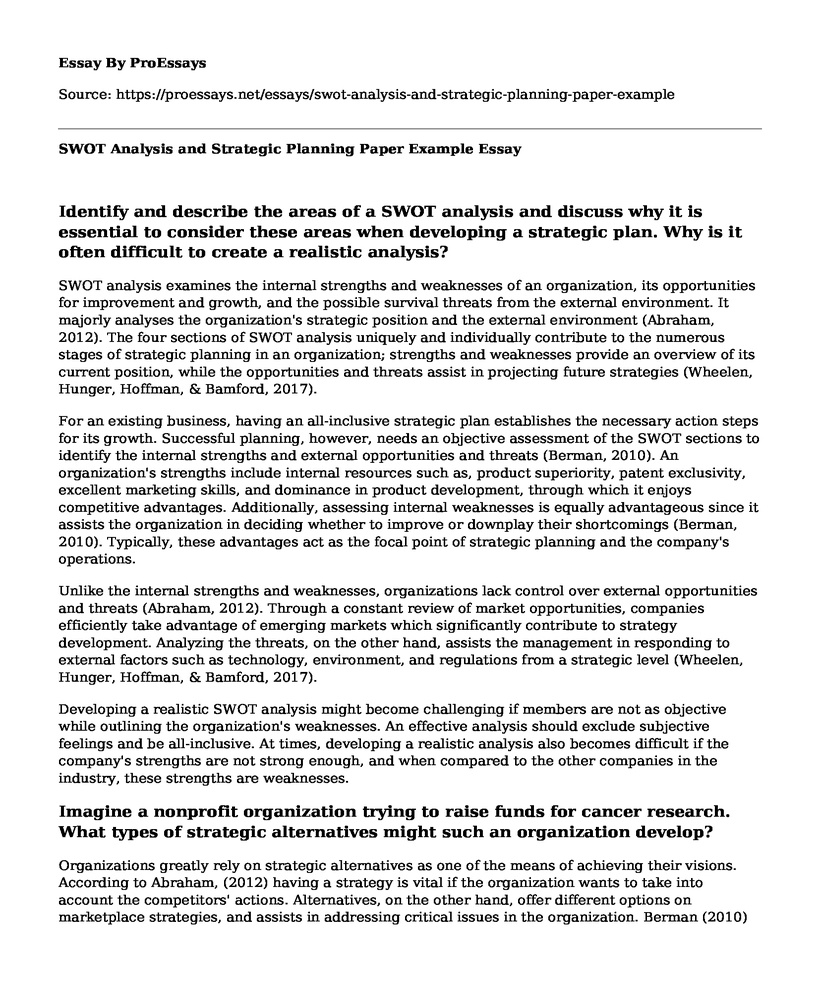Identify and describe the areas of a SWOT analysis and discuss why it is essential to consider these areas when developing a strategic plan. Why is it often difficult to create a realistic analysis?
SWOT analysis examines the internal strengths and weaknesses of an organization, its opportunities for improvement and growth, and the possible survival threats from the external environment. It majorly analyses the organization's strategic position and the external environment (Abraham, 2012). The four sections of SWOT analysis uniquely and individually contribute to the numerous stages of strategic planning in an organization; strengths and weaknesses provide an overview of its current position, while the opportunities and threats assist in projecting future strategies (Wheelen, Hunger, Hoffman, & Bamford, 2017).
For an existing business, having an all-inclusive strategic plan establishes the necessary action steps for its growth. Successful planning, however, needs an objective assessment of the SWOT sections to identify the internal strengths and external opportunities and threats (Berman, 2010). An organization's strengths include internal resources such as, product superiority, patent exclusivity, excellent marketing skills, and dominance in product development, through which it enjoys competitive advantages. Additionally, assessing internal weaknesses is equally advantageous since it assists the organization in deciding whether to improve or downplay their shortcomings (Berman, 2010). Typically, these advantages act as the focal point of strategic planning and the company's operations.
Unlike the internal strengths and weaknesses, organizations lack control over external opportunities and threats (Abraham, 2012). Through a constant review of market opportunities, companies efficiently take advantage of emerging markets which significantly contribute to strategy development. Analyzing the threats, on the other hand, assists the management in responding to external factors such as technology, environment, and regulations from a strategic level (Wheelen, Hunger, Hoffman, & Bamford, 2017).
Developing a realistic SWOT analysis might become challenging if members are not as objective while outlining the organization's weaknesses. An effective analysis should exclude subjective feelings and be all-inclusive. At times, developing a realistic analysis also becomes difficult if the company's strengths are not strong enough, and when compared to the other companies in the industry, these strengths are weaknesses.
Imagine a nonprofit organization trying to raise funds for cancer research. What types of strategic alternatives might such an organization develop?
Organizations greatly rely on strategic alternatives as one of the means of achieving their visions. According to Abraham, (2012) having a strategy is vital if the organization wants to take into account the competitors' actions. Alternatives, on the other hand, offer different options on marketplace strategies, and assists in addressing critical issues in the organization. Berman (2010) argues that alternatives have uncertain outcomes and adequate resources have to be acquired before taking actions.
For an organization to accomplish its vision, strategic alternatives must be considered (Wheelen, Hunger, Hoffman, & Bamford, 2017). . A non-profit organization, for instance, rely on these alternatives since in most cases they have to deal with the continuous decrease in federal and state grants which repeatedly depletes their budgets. Therefore, there are various methods of fundraising which can be used for a non-profit making organization aiming to conduct cancer research. These include the use of participation and team building events such as Relay for Life walkathons, where participants pledge donations based on the distance they can walk.
Another alternative would be the use of crowd funding, which involves the formation of an online donation fund (Lehner, 2013). It is the top fundraising alternative to raise funds for cancer research campaign since it is easy to start and cost-effective. Other useful options include charity concerts and holding teaching classes such as yoga and healthy eating.
References
Abraham, S. C. (2012). Strategic management for organizations. San Diego, CA: Bridgepoint Education, Inc
Berman, R. (2010, Spetember 21). Some Questions to Ask During a SWOT Analysis. Retrieved May 19, 2018, from Rob Berman's Blog: http://www.rob-berman.com/questions-to-ask-during-swot-analysis/Lehner, O. M. (2013). Crowdfunding social ventures: a model and research agenda. Venture Capital, 15(4), 289-311.
Wheelen, T. L., Hunger, J. D., Hoffman, A. N., & Bamford, C. E. (2017). Strategic management and business policy. pearson.
Cite this page
SWOT Analysis and Strategic Planning Paper Example. (2022, May 26). Retrieved from https://proessays.net/essays/swot-analysis-and-strategic-planning-paper-example
If you are the original author of this essay and no longer wish to have it published on the ProEssays website, please click below to request its removal:
- Organization Structure and Life Circle - Research Paper on Management
- Setting and Achieving Goals Essay
- Essay Sample on Leadership in Business
- Essay Sample on Positioning and Repsotioning a Product
- Essay Sample on Neptune Seafood Company: Cutting Prices or Cutting Losses?
- Essay on Preventing Workplace Violence: What I Learned at the Conference
- Essay Sample on Project Cost Overruns







